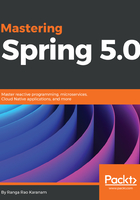
How does Spring Framework do this magic?
In the preceding example, Spring JDBC (and Spring, in general) converts most checked exceptions into unchecked exceptions. Typically, when a query fails, there is not a lot we can do--other than to close the statement and fail the transaction. Instead of implementing exception handling in every method, we can have centralized exception handling and inject it in using Spring Aspect-Oriented Programming (AOP).
Spring JDBC removes the need to create all the plumbing code involved in getting a connection, creating a prepared statement, and so on. The jdbcTemplate class can be created in the Spring context and injected into the Data Access Object (DAO) class wherever it is needed.
Similar to the preceding example, Spring JMS, Spring AOP, and other Spring modules help in reducing a lot of plumbing code.
Spring Framework lets the programmer focus on the primary job of a programmer-- writing business logic.
Avoiding all the plumbing code also has another great benefit--reduced duplication in code. Since all code for transaction management, exception handling, and so on (typically, all your cross-cutting concerns) is implemented at one place, it is easier to maintain.